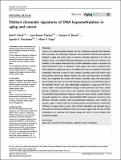Por favor, use este identificador para citar o enlazar a este item:
http://hdl.handle.net/10261/173554COMPARTIR / EXPORTAR:
 SHARE SHARE
 CORE
BASE CORE
BASE
|
|
| Visualizar otros formatos: MARC | Dublin Core | RDF | ORE | MODS | METS | DIDL | DATACITE | |

| Título: | Distinct chromatin signatures of DNA hypomethylation in aging and cancer |
Autor: | Pérez, Raúl F. CSIC ORCID; Tejedor, Juan Ramón CSIC ORCID ; Bayón, Gustavo F.; Fernández, Agustín F. CSIC ORCID; Fraga, Mario F. CSIC ORCID | Palabras clave: | Histone modification Epigenetics DNA methylation Chromatin Cancer Aging |
Fecha de publicación: | 2018 | Editor: | John Wiley & Sons | Citación: | Aging Cell 17(3): e12744 (2018) | Resumen: | Cancer is an aging-associated disease, but the underlying molecular links between these processes are still largely unknown. Gene promoters that become hypermethylated in aging and cancer share a common chromatin signature in ES cells. In addition, there is also global DNA hypomethylation in both processes. However, the similarity of the regions where this loss of DNA methylation occurs is currently not well characterized, and it is unknown if such regions also share a common chromatin signature in aging and cancer. To address this issue, we analyzed TCGA DNA methylation data from a total of 2,311 samples, including control and cancer cases from patients with breast, kidney, thyroid, skin, brain, and lung tumors and healthy blood, and integrated the results with histone, chromatin state, and transcription factor binding site data from the NIH Roadmap Epigenomics and ENCODE projects. We identified 98,857 CpG sites differentially methylated in aging and 286,746 in cancer. Hyper- and hypomethylated changes in both processes each had a similar genomic distribution across tissues and displayed tissue-independent alterations. The identified hypermethylated regions in aging and cancer shared a similar bivalent chromatin signature. In contrast, hypomethylated DNA sequences occurred in very different chromatin contexts. DNA hypomethylated sequences were enriched at genomic regions marked with the activating histone posttranslational modification H3K4me1 in aging, while in cancer, loss of DNA methylation was primarily associated with the repressive H3K9me3 mark. Our results suggest that the role of DNA methylation as a molecular link between aging and cancer is more complex than previously thought. | Versión del editor: | https://doi.org/10.1111/acel.12744 | URI: | http://hdl.handle.net/10261/173554 | DOI: | 10.1111/acel.12744 | Identificadores: | doi: 10.1111/acel.12744 e-issn: 1474-9726 issn: 1474-9718 |
| Aparece en las colecciones: | (CINN) Artículos |
Ficheros en este ítem:
| Fichero | Descripción | Tamaño | Formato | |
|---|---|---|---|---|
| distiagicanc.pdf | 4,42 MB | Adobe PDF |  Visualizar/Abrir |
CORE Recommender
PubMed Central
Citations
45
checked on 30-mar-2024
SCOPUSTM
Citations
65
checked on 15-abr-2024
WEB OF SCIENCETM
Citations
63
checked on 26-feb-2024
Page view(s)
299
checked on 14-abr-2024
Download(s)
214
checked on 14-abr-2024

